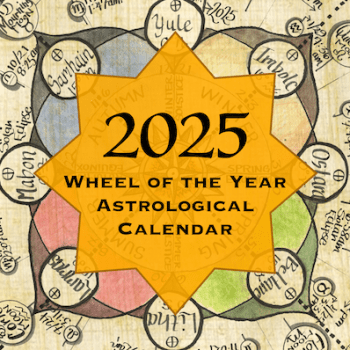A Pagan Almanac:
July 21, 2012
Lunar Cycle: Third day of the waxing Moon
Rome: The Lucaria
Athens: Hekatombaion 3, sacred to Athena
Martyred on this day in 1603:
James Reid of Musselburgh
He died in our name. Let us remember his.
_________________________________________
July 22, 2012
Lunar Cycle: Fourth day of the waxing Moon
Athens: Hekatombaion 4, sacred to Aphrodite, Hermes, and Herakles
Martyred on this day in 1612:
Agnes Brown,
Joan Vaughn,
Arthur Bill,
Helen Jenkinson,
Mary Barber,
All of Northampton
They died in our name. Let us remember theirs.
__________________________________________________________
William Blake wrote:
The Good are attracted by Men’s perceptions,
And think not for themselves;
Till Experience teaches them to catch
And to cage the Fairies & Elves.
And then the Knave begins to snarl
And the Hypocrite to howl;
And all his good Friends shew their private ends,
And the Eagle is known from the Owl.
_________________________________________
As I said last time, in using the scholarly techniques on the published texts of the “Old Laws,” I had hypothesized that they had been based on two older documents. In 1973 I still did not expect ever to see the kind of original documents that would allow me to satisfy my historical curiosity. To my surprise, all the necessary documents began to fall into my lap in 1974 and 1975. I need to emphasize that I was not a Gardnerian initiate when I began this research. I was simply a graduate student doing historical research on documents that were publicly available to anyone who wanted to see them.
In March 1974, soon after I had begun my Ph.D. studies at the Graduate Theological Union in Berkeley, my friend Isaac Bonewits was preparing to leave for St. Paul to become Editor of Llewellyn’s Gnostica. I mentioned to him the essay I had done on the Craft Laws, and he encouraged me to send it to him (it was subsequently published in Gnostica, in September 1974). When it arrived in May, he showed it to Carl L. Weschcke, President of Llewellyn Publications, who was thus reminded that he had a file full of Gardnerian materials, which he thought I might like to see. Isaac, upon looking through the file, recognized the importance of the materials, and immediately sent me photocopies of them and of some relevant correspondence from Gardner and others.
When I read through them the evening they arrived, I felt something like Champollion contemplating the Rosetta Stone, the bilingual inscription that made it possible to translate Egyptian hieroglyphics, for I could see that these were pages for a Gardnerian Book of Shadows. I was especially delighted that two of the eighteen documents made up the oldest copy I had yet seen of the Craft Laws (and are still the oldest extant text of the Craft Laws, as far as I know). I was also able to deduce immediately, by comparing them with Gardner’s letters, that the materials were typed and/or handwritten by Gardner himself; the handwriting matched, and so did the two different typewriter fonts. More importantly, that night I discovered that Gardner was marginally dyslexic. What I mean is that, despite his intelligence, which I do not propose to underestimate, and his avid reading and collecting of books, he simply did not spell or punctuate well enough to meet even minimal standards for being published, and his grasp of grammar was shaky at best. In other words, what I realized is that Gardner could not by himself have produced the books published in his name; he did carry out most of the basic writing, but he needed much help, almost a collaborator, to carry a book to its final draft. I began to wonder who had helped him. Philip Heselton’s Witchfather has detailed who these helpers were.
I later learned from Carl that the documents had been sent to him in about 1969 by Charles Clark, who had been initiated and trained about 1960 and served as Gardner’s secretary for the following four years. Clark’s identity had to be kept secret at that time, but since his passing, much about him has been written by his former Priestess, Melissa Seims, and can be found on her website at thewica.co.uk. One of the most intriguing revelations that Clark made to her was his belief that Gardner wanted the Book of Shadows to be published, not kept secret.
I was able to go to St. Paul in the summer of 1974 to examine the original documents. They were a motley assortment: some originals, but mostly carbon copies; typed variously on white bond, onionskin, and foolscap; of various sizes and conditions, some whole, some torn in half, some wrinkled from many foldings, some clean and never folded at all. Some had staple marks or holes punched in them, and had been fastened together in at least three different binders, no doubt being used in Books of Shadows; others show no marks and no sign of having seen such use. They were certainly not produced all at once, as a “fair copy” intended to be a single Book of Shadows. Instead, they were miscellaneous drafts from various stages of the writing process, typed on whatever was handy.
There was no way to be certain what in these 18 documents might have come from an older tradition. However, I realized that I could identify most of the quotes or paraphrases of published sources, and set these aside; I could then ask whether what remained made sense as being from anything like the sort of native pagan tradition that Gardner claimed. As I carried out this procedure, I discovered some interesting facts.
First, some of the drafts were different versions of the same basic ritual, and sometimes they incorporated revisions of other pieces of writing. I could therefore establish a relative internal chronology (“A is a revision of B; hence was written after B”). I also had some absolute dates for the bits of ritual and verse in Gardner’s books. I was thus able to establish that the 18 Weschcke documents were written between about 1954 and about 1960, and that most of them had probably been typed up about 1958 or 1959. This allowed me to see that many of the Book of Shadows rituals, including the most detailed forms of the initiations, did not exist in 1954 (when Witchcraft Today was published), but instead were still being written. If a “Gardnerian” coven is defined as one that works the basic Gardnerian rituals—and this is one of the basic rules by which Gardnerian covens judge the authenticity of any coven that claims to be Gardnerian—then no Gardnerian coven could have existed before 1955, because the basic Gardnerian rituals had not yet been written.
Second, the major published sources from which the rituals had been constructed included: (a) Mathers’ edition of The Greater Key of Solomon; (b) Aleister Crowley’s Magick in Theory and Practice; (c) Leland’s Aradia; (d) some Masonic rituals akin to those described by Duncan and those of the Hermetic Order of the Golden Dawn (aside from those transmitted by Crowley); and (e) Margaret Murray’s The Witch Cult in Western Europe. There were also bits and pieces from other works by Leland, Jane E. Harrison, Gilbert Murray, James Frazer, and the other great classicists and mythologists of the 19th century. That accounted for everything in the rituals! There was nothing left that differed in any important way from what you can find in those sources–but that is NOT at all what Gardner had claimed.
Still, all that applies only to the rituals in the Book of Shadows; and should not be a startling conclusion, because anyone familiar with western magical traditions can see that the Gardnerian rituals derive from a magical system much like the (essentially Masonic) system of the Hermetic Order of the Golden Dawn, not from any native British religious traditions. Furthermore, the Gardnerians admit that the rituals are exactly where Gardner did the most reconstruction work. Rather, they claim that the pre-1939 stratum is one of concept, customs, traditions, laws, and, in brief, the sorts of things incorporated in the Craft Laws, which is almost the only piece of writing in the Book of Shadows that claims to be (and at least logically could be) historical.
I had suspected that the Gardnerian claim to historicity must stand or fall on “The Old Laws” ever since I had first seen it, and my analysis of the two typed parts of it among the Weschcke documents simply left the question open. Because it was typed in two parts, which exhibit some curious internal parallels, I thought both parts might have been derived from an older, common source document—and it was that hypothetical older document I hoped to find when I went to Toronto in 1975.
I had known there was another possible source of information about Craft history, in the documents and letters acquired by Ripley’s International, Ltd., Toronto, when it bought the contents of Gardner’s Witchcraft museum on the Isle of Man. In June 1974, before my visit to St. Paul, I had stopped by the Ripley Museum of Witchcraft at Fisherman’s Wharf in San Francisco, looked over their exhibits, and introduced myself to the manager, Charles Thielen. When I had explained the purpose of my research to him, he offered to write a letter to the corporate headquarters on my behalf, and as a result I received an invitation to visit their offices in Toronto and examine their holdings.















